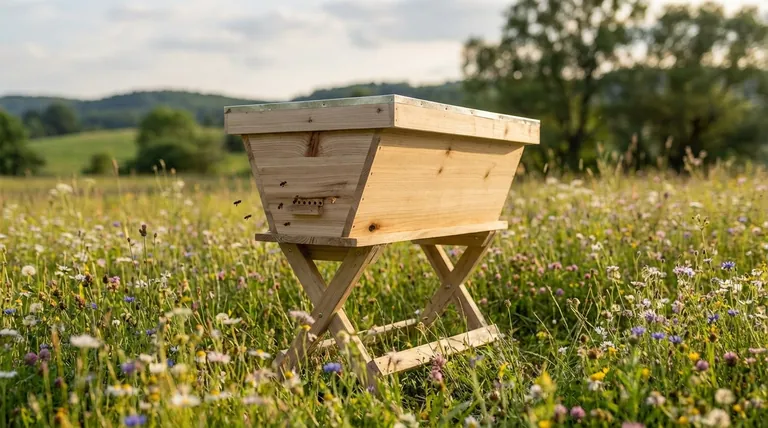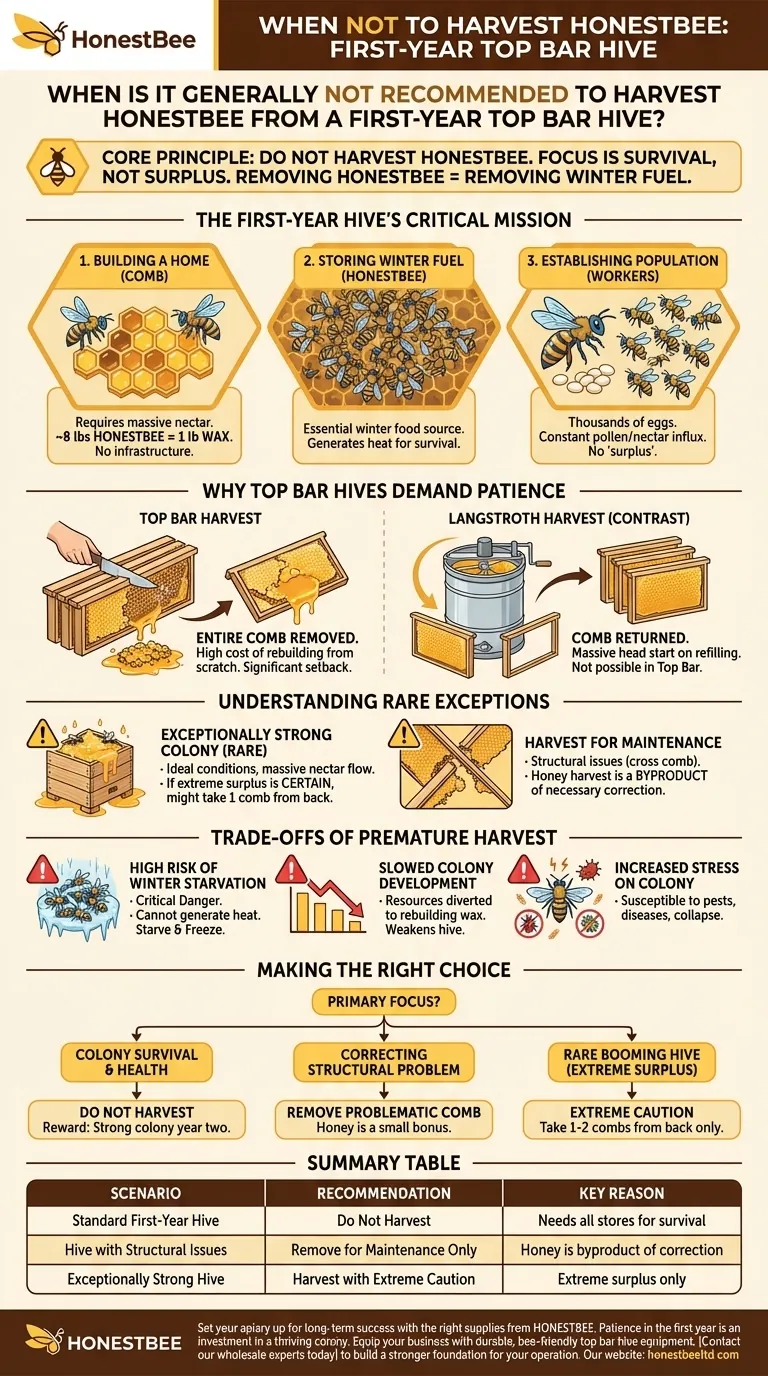In almost all cases, you should not harvest honey from a first-year top bar hive. A new colony's entire focus during its first season is establishment. They must dedicate all their energy to building wax comb, raising a large worker population, and storing enough honey to survive their first winter.
The core principle is simple: a first-year hive is not focused on producing a surplus for you; it is focused on its own survival. Removing honey, and therefore their winter fuel, is one of the most common and fatal mistakes a new beekeeper can make.

The First-Year Hive's Critical Mission
A new package or swarm of bees is starting from absolute zero. Their success hinges on accomplishing several energy-intensive tasks before the cold weather arrives.
Building a Home from Scratch
A new colony has no existing infrastructure. The bees must consume large amounts of nectar—roughly 8 pounds of honey to produce 1 pound of wax—to meticulously draw out every single wax comb that will house their brood and store their food.
Storing Winter Fuel
Honey is not a bonus product for the bees; it is their essential winter food source. Bees use the carbohydrates in honey to vibrate their flight muscles, generating the heat needed to keep the colony cluster alive through freezing temperatures.
Establishing a Strong Population
The queen needs to lay thousands of eggs to build a robust workforce for foraging and hive maintenance. This requires a constant influx of pollen and nectar, leaving little room for a "surplus" in the first year.
Why Top Bar Hives Demand More Patience
The design of a top bar hive fundamentally changes the harvesting process and its impact on the colony, especially when compared to a standard Langstroth hive.
The Entire Comb is Removed
In a top bar hive, harvesting honey means using a knife to cut the entire wax comb away from the top bar. This comb is then crushed and strained to release the honey.
The High Cost of Rebuilding
Because the entire comb is removed, the bees suffer a significant setback. They must expend enormous energy and resources to rebuild that comb from scratch before they can even begin to store new honey in that space.
Contrast with Frame Hives
In a Langstroth hive, beekeepers use an extractor to spin honey out of the frames. The empty wax comb is then returned to the hive, giving the bees a massive head start on refilling it. This option does not exist in top bar beekeeping.
Understanding the Rare Exceptions
While the rule is to leave first-year hives alone, there are two specific scenarios where removing a comb may be necessary.
The Exceptionally Strong Colony
In very rare cases, with an ideal climate and a massive nectar flow, a first-year hive may be so prolific that it completely fills the hive body from one end to the other with comb, brood, and honey. If you are certain they have an extreme surplus well beyond their winter needs, you might consider taking a single comb from the very back.
Harvesting for Hive Maintenance
Sometimes a comb is built incorrectly. Bees may build "cross comb," attaching a single comb to multiple top bars, making inspections impossible. In this case, the comb must be removed to maintain the hive. Harvesting the honey from this removed comb is a byproduct of necessary maintenance, not the primary goal.
The Trade-Offs of a Premature Harvest
Taking honey too early from a first-year hive is not a neutral act. It comes with significant risks that directly threaten the colony.
High Risk of Winter Starvation
This is the most critical danger. A colony without adequate honey stores will not be able to generate enough heat to survive the winter. They will starve and freeze.
Slowed Colony Development
Forcing the bees to divert resources back to building wax sets the entire colony back. It slows population growth and their ability to forage, weakening the hive as it heads into its most vulnerable season.
Increased Stress on the Colony
The combined pressure of lost food stores and the urgent need to rebuild their home puts immense stress on the bees. A stressed colony is more susceptible to pests, diseases, and collapse.
Making the Right Choice for Your Goal
Your approach in the first year should be guided by a clear understanding of the colony's needs, not your own desire for honey.
- If your primary focus is colony survival and long-term health: Do not harvest any honey in the first year. Your reward will be a strong, thriving colony in year two.
- If your primary focus is correcting a structural problem: Remove the problematic comb as needed, and consider the honey a small bonus from your maintenance work.
- If you have a rare, booming hive that has filled all its bars: Proceed with extreme caution, taking only one or two combs from the honey-only section at the very back of the hive.
Patience in the first year is the single greatest investment you can make in the future productivity and health of your top bar hive.
Summary Table:
| Scenario | Recommendation | Key Reason |
|---|---|---|
| Standard First-Year Hive | Do Not Harvest | Colony needs all honey stores to build comb and survive its first winter. |
| Hive with Structural Issues (e.g., cross comb) | Remove Comb for Maintenance Only | Harvesting honey is a byproduct of necessary hive correction. |
| Exceptionally Strong, Full Hive | Harvest with Extreme Caution | Only consider taking 1-2 combs if the hive has a clear, extreme surplus. |
Set your apiary up for long-term success with the right supplies from HONESTBEE.
Your patience in the first year is an investment in a thriving, productive colony. Equip your commercial apiary or distribution business with durable, bee-friendly top bar hive equipment and supplies designed to support healthy hive establishment and growth.
Contact our wholesale experts today to discuss your beekeeping supply needs and build a stronger foundation for your operation.
Visual Guide

Related Products
- Top Bar Beehive for Beekeeping Wholesales Kenya Top Bar Hive
- Long Langstroth Style Horizontal Top Bar Hive for Wholesale
- HONESTBEE Professional Long Handled Hive Tool with Precision Cutting Blade
- HONESTBEE Professional Multi-Functional Hive Tool with Ergonomic Wood Handle
- HONESTBEE Advanced Ergonomic Stainless Steel Hive Tool for Beekeeping
People Also Ask
- How should a beekeeper prepare a top-bar hive for overwintering? A Guide to Ensure Colony Survival
- What are the advantages of harvesting honey from a top bar hive? Low-Cost, Simple Harvesting for Beekeepers
- Why are hive inspections easier with Top Bar Hives? Achieve a Calmer, Safer Approach to Beekeeping
- What are the benefits of a top bar hive? A Natural, Low-Impact Approach to Beekeeping
- What are the benefits of extra wax production in top bar hives? A Natural Byproduct for Craft & Efficiency



















